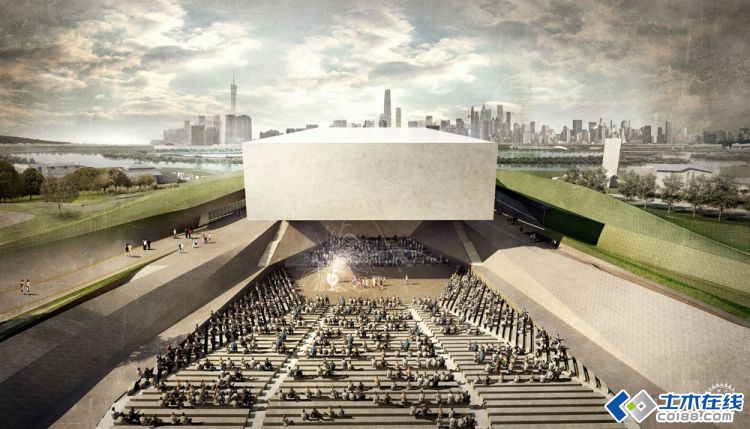来自专筑编辑雷君的报道。从古典的中国建筑中,我们认为建筑是线性平面。多数宗教性场所,如传统的中国建筑都经历了这样一个序列,围绕着一个中心穿梭。这个电影场景般的本土序列形成了一系列地上物,共同产生了从城市规模经景观(公园)最后归于河岸的无缝过渡。插入的中心轴(严格对称)被曲线干扰,它周围的景观徐徐流动,产生漩涡和涟漪,轻轻地指引着游客的轨迹。所有建立直接链接编排的可能性都用演艺中心作为关键结合点进行设计,在此,人流汇聚、分流、具化为空间形态系统。

来自专筑编辑雷君的报道。从古典的中国建筑中,我们认为建筑是线性平面。多数宗教性场所,如传统的中国建筑都经历了这样一个序列,围绕着一个中心穿梭。这个电影场景般的本土序列形成了一系列地上物,共同产生了从城市规模经景观(公园)最后归于河岸的无缝过渡。 插入的中心轴(严格对称)被曲线干扰,它周围的景观徐徐流动,产生漩涡和涟漪,轻轻地指引着游客的轨迹。所有建立直接链接编排的可能性都用演艺中心作为关键结合点进行设计,在此,人流汇聚、分流、具化为空间形态系统。 我们的计划强调将轨迹作为造景元素,其印痕产生不同尺度的组合,将地面分割开,剥落表面,露出下面的草,创建阴影和座位。 From Classical Chinese architecture we thought out the organization of the building as a linear sequence of planes. Most sacred sites such as the traditional Chinese architecture are experienced in such a sequence, weaving in and out of a central. This cinematic–yet vernacular–sequence frames a series of projections that together produce a seamless transition from the urban (city) scale through the landscape (park) scale and into the riverbank. The imposed central axis (imposing rigid symmetry) is disturbed by the curvilinear, meandering flows of the landscape around it, producing twirls and ripples that guide and gently affect the visitors' trajectory. All possibilities to establish direct links are choreographed using the presence of the performance centre as the key articulation point, where flows are collected, channelled and materialised into a manifold of spatial configurations. Our proposal emphasizes the trajectories as the formative element of the landscape, where their imprint produce folds of various scales, ripping off the ground, peeling off the surface, uncovering the grass beneath and creating shading and sitting devices. 
这一建筑基本上保持了其天然的形态:属于这个历经变迁的公园的石块,逐渐被风侵蚀,被基地的水流雕琢。这种形态的变化也代表了在周边环境中其他进程的存在。以对称原理作为对公园通道的非层次回应,两侧各有一条“沟渠”被省却,创造出隐蔽通道和风路。建筑物的东南面也被腐蚀,以顺应向上开口的风向,并捕获它流动的轨迹。 The building appears primarily as a natural formation: a stone mass belonging to the park from previous times that has changed gradually along the years; eroded by the wind, carved by flows drifting through the site. In this way the shifts in its morphology are indexical of other processes occurring within its surroundings; in principle symmetric as a non-hierarchical response to the accesses to the park and the relationship to the main plaza, two ‘ditches’ are eaten away at both sides of the performance area, creating sheltered passages and channelling the wind. The southeast flank of the building is also corroded to align to the prevailing wind direction opening up towards it and capturing its flows. 
|
